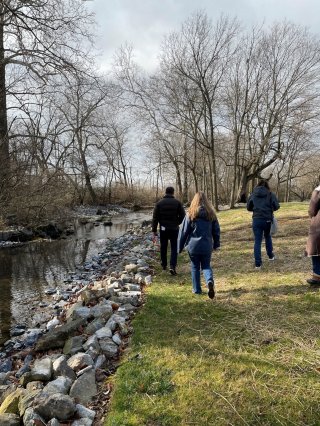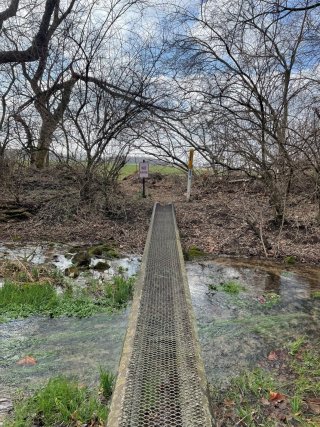Bringing a Local Stream Back to Life
Teamwork makes the dream work! A once stagnant stream is flowing once again thanks to a partnership between the Franklin County Conservation District, the Western Pennsylvania Conservancy (WPC) and the Pennsylvania Fish and Boat Commission (PFBC). This partnership collaborated with the Greencastle-Antrim School District (GCASD), Kerri Barnes, Director of Tayamentasachta Center for Environmental Studies, a local church, and private landowners to restore a picturesque stream in Franklin County, Pennsylvania.
Locals wanted to see the once clear, knee-deep stream they had fished and played in brought back to life. The Paddy Run Stream seemed like the perfect place to test the new Streamlined Stream Restoration initiative that was outlined in the Franklin County Clean Water Plan.
Restoring the Paddy Run Stream

The restoration team installed special structures that create a fish habitat that creates protection from prey and creates a space for fish reproduction and feeding. These habitats also double as streambank stabilization, preventing land erosion while narrowing the stream channel to increase the flow speed and depth. These changes increase the amount of oxygen in the stream and help rebuild the natural stream bank and channel, bringing it closer to its original condition.
In only a few short months, sediment began rebuilding in the streambanks and fish have begun to return. Vegetation returned and the wetlands are expanding, with crystal clear and deep water flowing in the stream.
Funding for the stream restoration project included grant funding from the Pennsylvania Environmental Stewardship Fund through the Countywide Action Plan Block Implementation Grant. The overall project cost to restore the stream was approximately $35,000, with the only out-of-pocket expense to the landowners being a $50 permit, paid for by Greencastle-Antrim School District.
Timeline of a Stream Restoration

Small Streams Making a Big Impact

Spring-fed streams like Paddy Run are the smallest piece of river and stream networks, but these important headwater streams dictate the physical and chemical characteristics of larger bodies of water and streams.
Franklin County is part of the Chesapeake Bay watershed, which stretches across 6 states: New York, Pennsylvania, Maryland, West Virginia, Delaware, Virginia, and the District of Columbia. The Chesapeake Bay watershed covers nearly 64,500 square miles and drains 7 major rivers: the Susquehanna, Potomac, Patuxent, Choptank, Rappahannock, York, and James Rivers.
When we start with clean water, we instantly reduce the amount of nutrients reaching larger bodies of water. Not only has a local stream in Franklin County been restored and preserved for future generations, but restoration efforts like these reduce nutrients and pollutants on a larger scale that could be transported to the Chesapeake Bay. Paddy Run may be small, but the smallest streams often have the biggest impact.
This project is truly a testament to the power of local partnerships when it comes to protecting our natural resources and local assets like Paddy Run Stream.
- Review a presentation of the Paddy Run Restoration Project (pdf)
- Watch a video spotlight of the Paddy Run Stream restoration
- Franklin County Conservation District
- Western Pennsylvania Conservancy
- Pennsylvania Fish and Boat Commission

About the Author
Christine Gonnelli
Public Affairs Specialist
Region 3
Christine Gonnelli is a Public Affairs Specialist for EPA Region 3. She's been a part of the Region 3 team since July 2022, where she manages Region 3's social media and also does internal communications. Before working for EPA, she was an Assistant Public Information Officer for the County of Burlington in New Jersey. She enjoys finding creative ways that show how EPA employees are passionate about protecting our environment.
Editor’s Note: The views expressed here are intended to explain EPA policy. They do not change anyone’s rights or obligations. You may share this article. However, please do not change the title or the content, or remove EPA’s identity as the author. If you do make substantive changes, please do not attribute the edited title or content to EPA or the author.
EPA’s official web site is www.epa.gov. Some links on this page may redirect users from the EPA website to specific content on a non-EPA, third-party site. In doing so, EPA is directing you only to the specific content referenced at the time of publication, not to any other content that may appear on the same webpage or elsewhere on the third-party site, or be added at a later date.
EPA is providing this link for informational purposes only. EPA cannot attest to the accuracy of non-EPA information provided by any third-party sites or any other linked site. EPA does not endorse any non-government websites, companies, internet applications or any policies or information expressed therein.
